Sciatica Exercises: The 4 Best Exercises
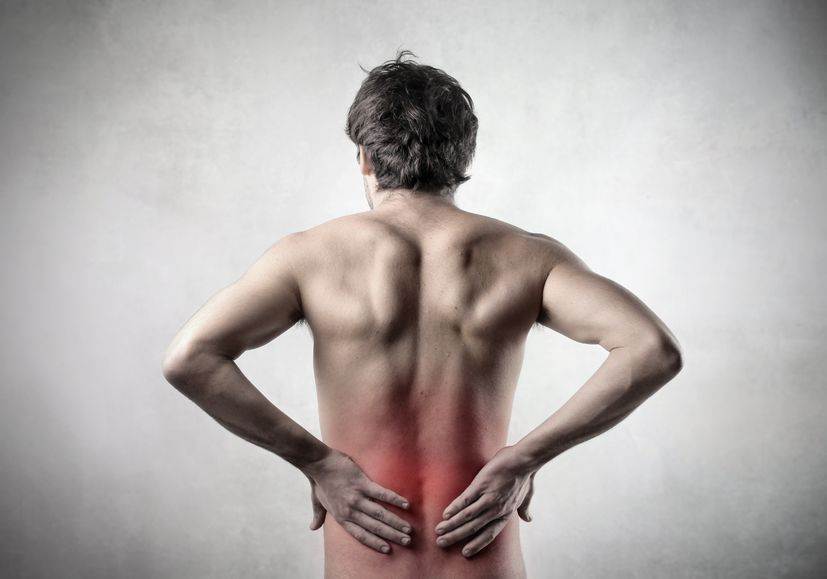
Discover the Best Sciatica Exercises for Pain Relief and Recovery
Persistent sciatica pain can transform daily activities into daunting tasks, leaving you searching for relief. If you’re on the hunt for effective strategies to alleviate sciatica and bolster your rehabilitation, welcome to your comprehensive guide. Here, we delve into not only the treatment options but also spotlight sciatica exercises that are crucial for pain relief and recovery. These exercises, when integrated with the professional care from your chiropractor or physiotherapist, are designed to reduce sciatica symptoms significantly.
Why Focus on Sciatica Exercises?
Exercises specifically tailored for sciatica play a pivotal role in managing and reducing pain. They are essential for strengthening the muscles supporting your spine, improving flexibility, and promoting healthy circulation to the affected nerve regions. This guide is your go-to resource for understanding how targeted exercises can complement medical treatments and accelerate your journey to relief and rehabilitation.
Understanding Sciatica: Sciatica Exercises
Sciatica is often described as a painful sensation that originates in the lower back or buttock, extending down through the thigh and leg, and occasionally reaching the foot. This discomfort results from the compression or irritation of the sciatic nerve. However, the root cause of this pinching can vary, necessitating precise diagnosis and tailored treatment plans.
The Complexity of Sciatica Causes: Sciatica Exercises
Identifying the exact source of sciatica is crucial, as nerve compression can occur at multiple points along its path. Misdiagnosis or oversimplification of your condition as merely “sciatica” without further investigation can lead to ineffective treatment strategies. It’s essential to understand whether the pain stems from issues like disc herniation, degenerative disc disease, or another underlying cause to ensure the appropriate therapeutic approach is employed.
See Also: Best Toronto Chiropractor: How To Find The Best Chiropractor In Your City
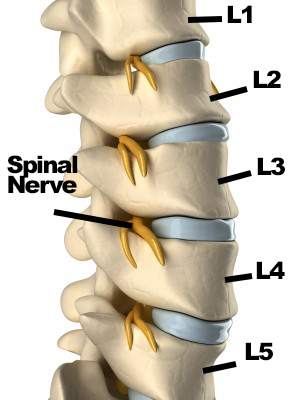
L4 and L5: Sciatica Exercises
So how do I know where my pinched nerve is? Two nerves come out between the last two vertebrae in your body. Your nerve is very commonly pinched here.
Your lower back vertebrae are called lumbar vertebrae. There are 5 vertebrae in the lower back. Taking the “L” for the lumbar spine, they are named L1, L2, L3, L4, and L5. The last two vertebrae in your lower back are L4 and L5.
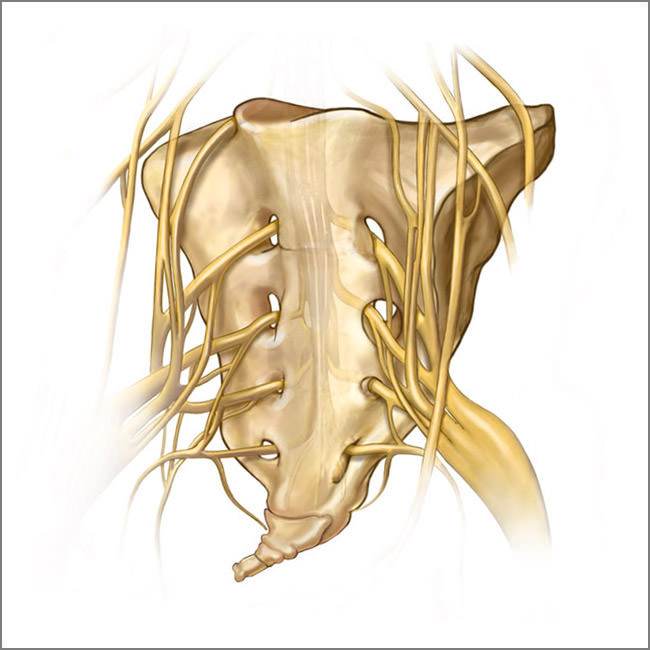
Ion medical designs http://www.ionmedicaldesigns.com/ion_site/two_dimensional_artwork.html
Just below L5 is one of your pelvic bones. It’s called the sacrum. The sacrum has holes with yellow-coloured nerves coming out.
S1, S2, S3: Sciatica Exercises
The nerves are called S1, S2 and S3. “S” is for sacrum. These nerves are rarely pinched.
Your sciatic nerve is formed when the nerves from L4 L5 and L5 S1 join together with the S1, S2 and S3 nerves in your buttock.
So, most of you will have your nerve pinched in one of three spots.
- In the buttock the Sciatic Nerve starts, in other words where the S1, S2, and S3 nerves join the two other nerves that come out between L4, L5 and L5 S1.
- Between L4 and L5 vertebrae
- Between L5 and S1 vertebrae
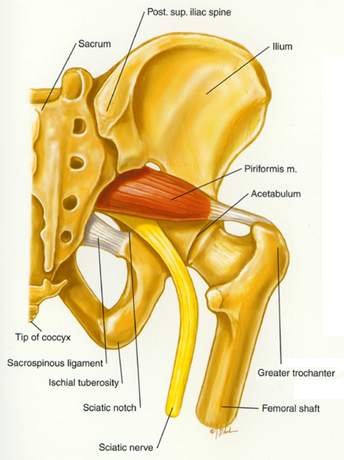
Now you know where the nerve can be pinched but it doesn’t answer why one of the nerves is pinched causing your sciatica
The Usual Suspects (Causes) of Sciatica
Most people’s sciatica is from:
- Herniated Disc at L45 or Herniated Disc at L5S1 (some osteoarthritis = “wear and tear” is involved)
- Degenerative Disc Disease (Osteoarthritis of the Disc=”Wear and Tear” of the Disc)
- Stenosis (Basically advanced osteoarthritis)
- Spondylolisthesis (A fracture of the vertebra or Osteoarthritis with the vertebra moving forward)
- Piriformis Syndrome
These are the diagnoses that your doctor or chiropractor should be telling you about not sciatica.
Remember sciatica only says that you have a pinched sciatic nerve causing pain in your buttock and leg, sciatica doesn’t tell you the cause of your pain. Without determining the cause you will get hit-or-miss treatments from your chiropractor or physiotherapist as they can’t give you specific treatment.
See Also: MRI CT scans X-rays, What’s Best For My Pain
The key exam that you need to determine what the heck is causing your pain is a neurological examination. You have probably seen it on TV before.
- Reflex tests with a reflex hammer on your knee and the back of your ankle
- Muscle Strength Testing: Resisted muscle testing of your foot. You try and push up/down while the chiropractor holds your foot. An alternative is heel walking and walking on your toes.
- Light Touch and Sharp Dull Testing: A light touch directly on the unclothed legs and feet to determine if you are unequal in your sensitivity to light touch and sharp/dull testing. A light touch is often enough as a screening.
Also, remember that the diagnosis should pretty much be determined in the office and X-rays, MRI, and CT scans done only if there are signs of something else or the diagnosis is kind of fuzzy.
See Also: Herniated Disc Part 2: The Best Exercises For Your Herniated Disc
Herniated Disc: Sciatica Exercises
You herniate a disc from the everyday habits that you have. The everyday habits of slouching and bending with a rounded low back, build up to weaken and damage the disc to the point it is ready to break open and herniate.
The problem is there is no pain. You don’t feel sciatica until the disc has herniated as there are no nerves inside the disc. So you continue your habits and think you don’t have a bad back until one day you lift your daughter off the floor.
The only problem is you had a bad back with no symptoms for a very long time. This is just like a car with a little bit of rust showing but if you take the car apart you see a lot more rust.
Degenerative Disc Disease – Osteoarthritis of the Disc
Degenerative Disc Disease is a continuation of the breakdown of the disc that was started by bad lifting and slouching habits.
The disc becomes smaller, and brittle like an old elastic band that is decaying, leading to the disc becoming smaller in height. The smaller disc makes the space between the vertebrae smaller. Thus, your nerve doesn’t have much room, so your nerve gets pinched between L4 and L5 or L5 and S1.
Stenosis- Most commonly from continuation of Osteoarthritis
Stenosis is a “narrowing”. There are two types of stenosis
- Lateral Stenosis
- Spinal Stenosis
1. Lateral Stenosis is the narrowing of the hole which the nerves from the spinal cord come from. Does this sound familiar? It’s degenerative disc disease + the bone degenerating forming spurs that narrow the hole for the nerve. A smaller hole for your nerve eventually means a pinched nerve.
2. Spinal Stenosis is the narrowing of the canal where the spinal cord sits. This is essentially pinching of the spinal cord usually in the lower back.
Spondylolisthesis (Vertebebra moving forward)
Spondylolisthesis is usually the moving forward of the vertebra (sometimes backwards). When the vertebra moves forward the spinal cord and nerves are pulled putting tension on your nerve. Nerves under tension get irritated and so turn into sciatica. This can happen from a fracture to the vertebrae or osteoarthritis.
Piriformis Syndrome
Most people’s sciatic nerve usually goes over or under the piriformis muscle. In some cases, possibly yours, the sciatic nerve goes right through the piriformis muscle. When the muscle tightens up it squeezes on the sciatic nerve causing sciatica.
Walking like a “man” is another reason for sciatica. That’s right, when you walk bow-legged with your feet turned can give you trouble later.
Chances are, if you are reading this you already have a problem with sciatica. When you turn your feet out this makes the piriformis muscles work harder.
The harder your piriformis works the more likely the nerve will be pinched causing sciatica.
The 4 Best Exercises For Sciatica
While treatments are different for sciatica depending on the cause you can still help your chiropractor or physiotherapist by doing your home exercises.
1. Flossing: first introduced by Michael Shacklock
Flossing is good for your teeth but a different kind of flossing is good for your spine and spinal hygiene.
First, determine if you can floss safely:
- Sit on a chair or relatively hard surface. Please don’t sit on the couch, it is too soft and will aggravate your lower back.
- Raise your painful leg to the point of pain and keep it there.
- Bend your neck forward till your pain is aggravated from above
- Lower the leg till the pain decreases.
If the pain decreases you are safe to do flossing.
Warning: This exercise can cause acute sciatica but chances are minimized by doing the screening exercise. Don’t floss until you have been out of bed for at least 2 hours. Now The Flossing:
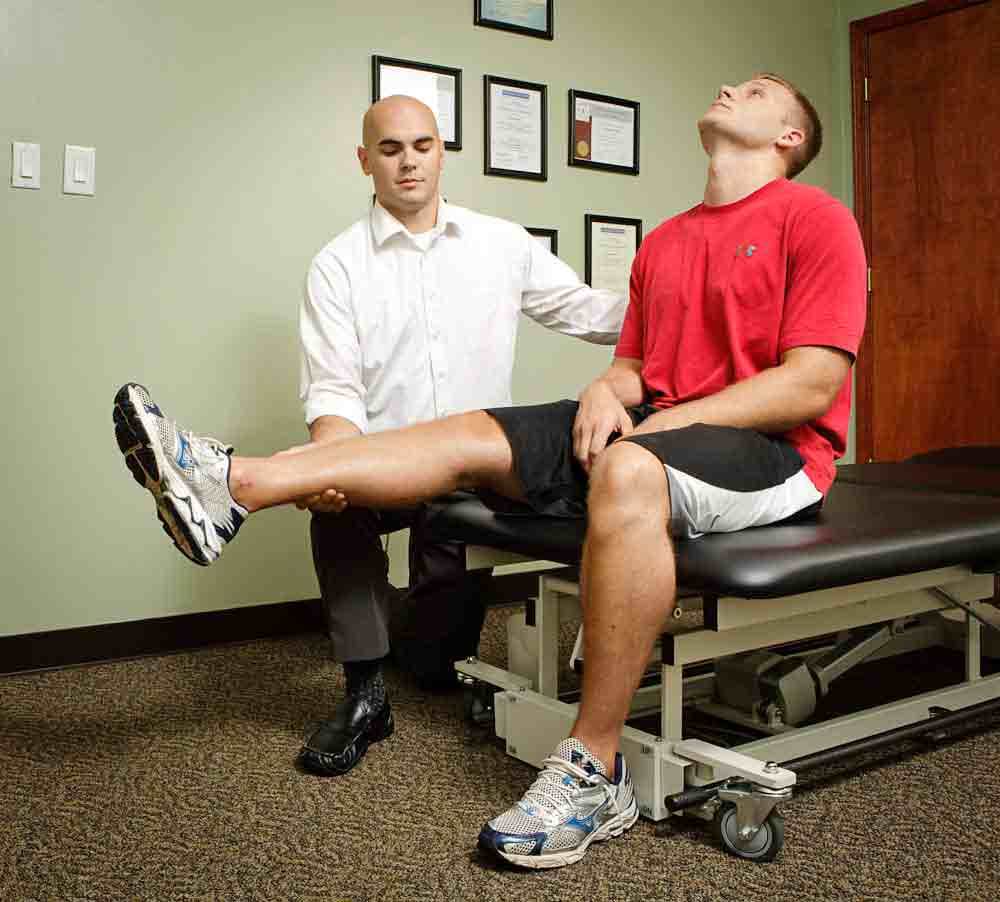
- Sit down in a chair with your legs swinging freely
- Bend your neck forward for 5 seconds (if this doesn’t cause sciatica you can do the next step)
- Bend your neck backwards as far as possible and straighten the knee (5 seconds)
- Repeat 3 sets of 10X on each leg. You can do this for up to 5/day.
2. Piriformis Stretch A) Sitting and B) Lying Face-Up
A: Sitting:
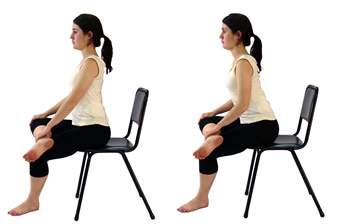
- Sit in a chair and cross the bad leg over the good
- Keep the arch in your back and move your chest forward
- Repeat 3 sets 30 secs. This can be done several times a day
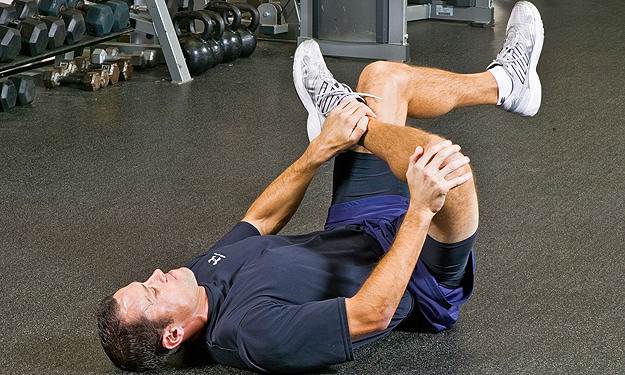
B: Lying Face-up: This exercise might be easier for some of you.
- Lying Face-up both knees bent. Put the bad leg over the good.
- Bring the good leg up to support the bad leg.
- Push the bad leg outward.
3. Ball Exercises: Piriformis, Gluteus Maximus, Gluteus Medius
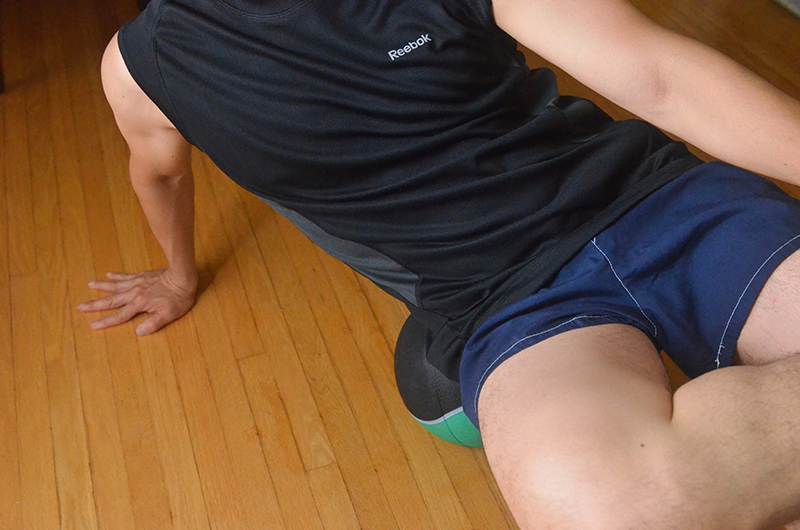
Piriformis
- Cross your bad side leg over the other knee
- Get a tennis ball, basketball or a medicine ball and sit on it with your buttock.
- To treat the piriformis go lean at about a 45-degree angle.
- Stop at each tender point and hold until each one is ironed out or feels less tender.
Gluteus Maximus
- Same as the piriformis except that you don’t need to cross the bad over the good.
Gluteus Medius
- Same as Gluteus Maximus except that you now lean at almost a 90-degree angle -You are almost on your side with a focus on the side area just below the belt or hip bone
4. Cobra
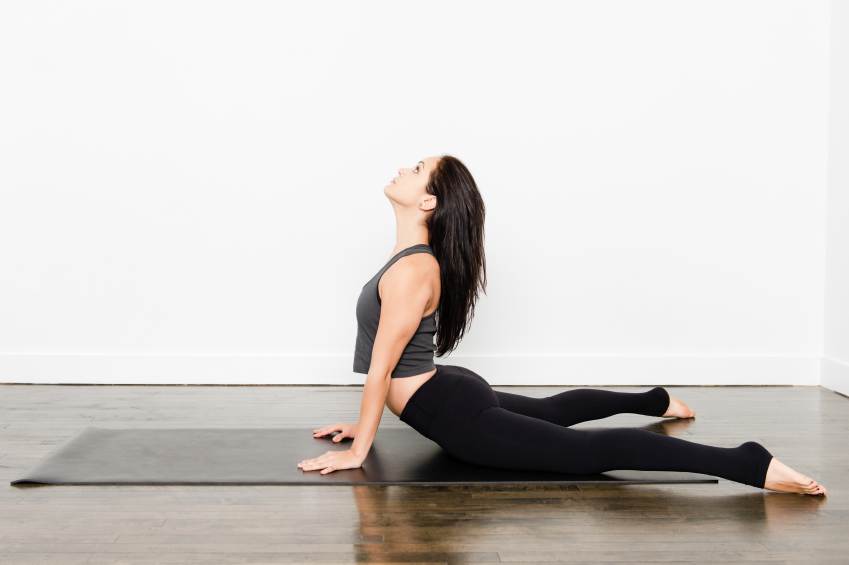
- Lie down face down with your hands underneath your shoulders.
- Push up from as high as you can until your lower back stops you or your elbows are straight.
- The pelvis should still be on the floor and the lower back muscles relaxed.
- Do these exercises hold each time for 1-2 seconds 6-8 times per set? This exercise can be repeated every two hours throughout the day.
If your pain is from a disc herniation you can combine the disc herniations part 2 exercises with these exercises. If your sciatica is from a different cause I will write about all the conditions that cause sciatica over time.
Write in the comments to tell us how you are doing with your sciatica. Also, let us know your vote for the best Toronto Chiropractor below. Connect with me on LinkedIn.


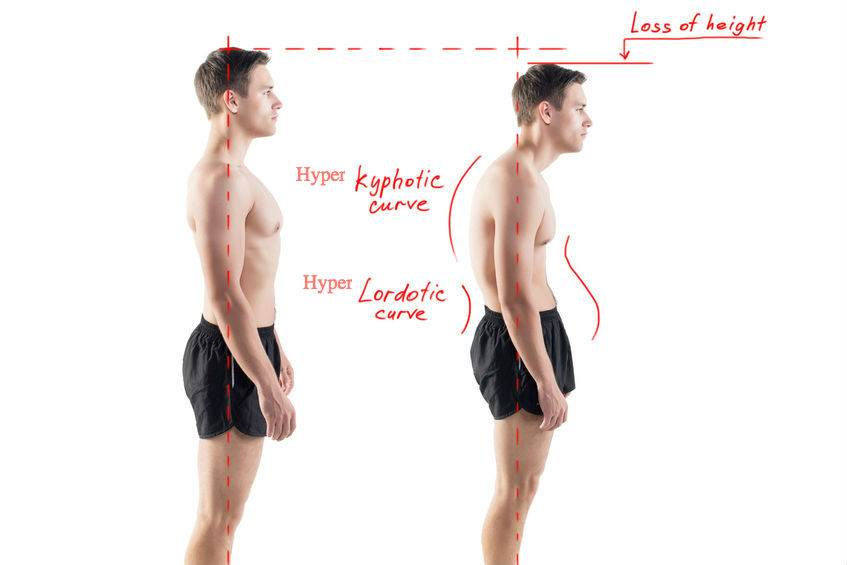
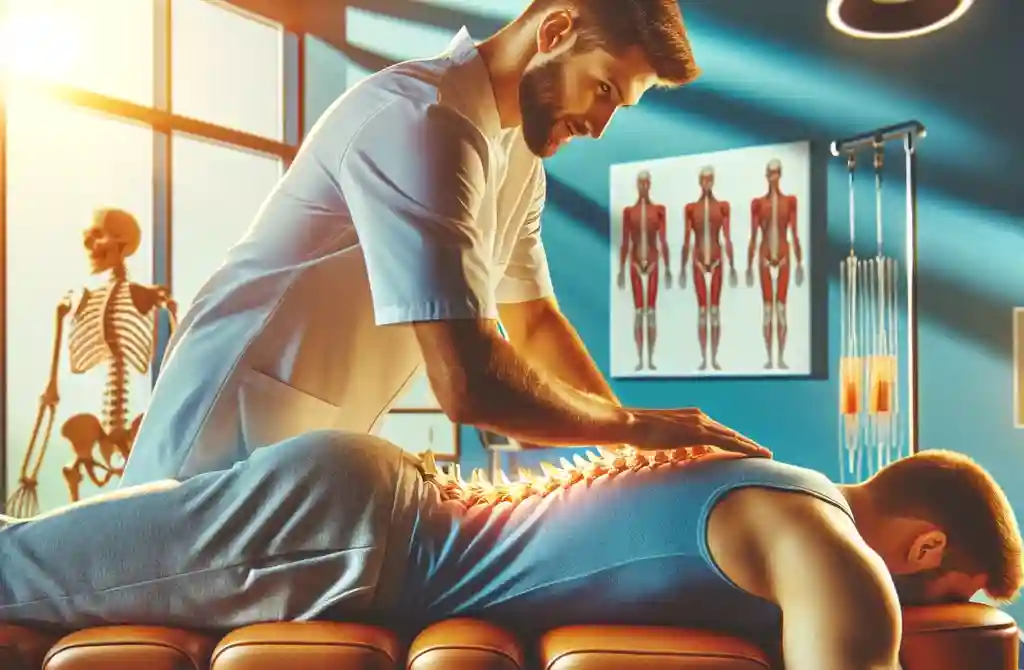
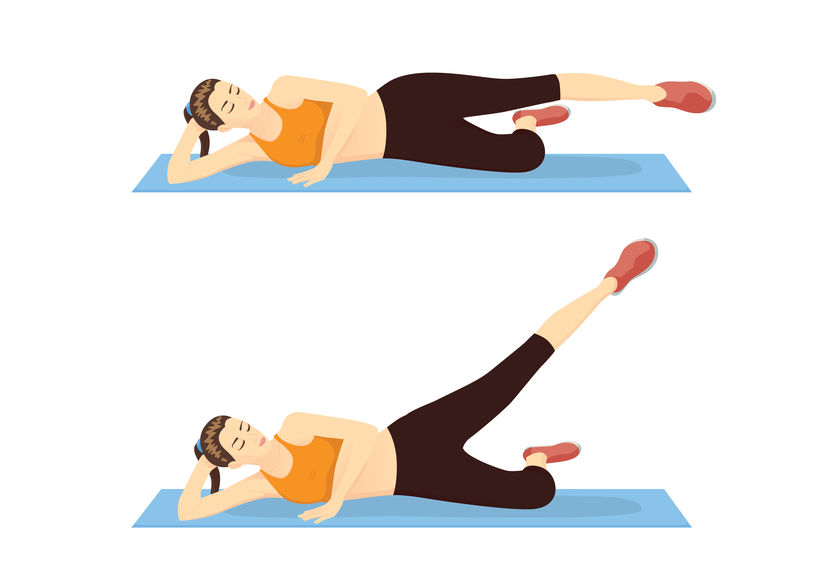
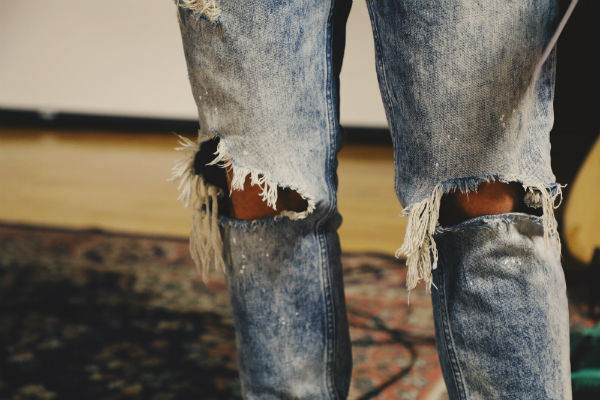
Hi Dr. Nakamura
These exercises you recommend help a lot! thank you! I have been diagnosed with peroformis syndrome. I have pain in buttocks when I sit . Any suggestions on other exercises to get rid of this pain. Is myofascia release and massage ok? or a gentler approach?
E
Author
Thanks for your question El. Yes Myofascial release or ART active release technique and massage all help. So would chiropractic treatments for your local chiropractor.
Hope that helps your sciatica.
Hi Dr ken,
My MRI report says ‘Diffuse disc bulge with central protrusion/herniation and L5/S1’
Regarding pain, not much in pain in my legs or buttocks or calves maybe since its more than 2 weeks prior to injury which happened because of deadlifting.
Not taking medicines, exercises doing it sometimes, but reading regarding others with kind of similar L5/S1 seems there is alot of pain.
So what should I do to stay away from pain and can It heal itself or it cannot??
Author
Thanks for for your question Salman. Assuming you are not the other Salman it doesn’t sound like the disc is your problem. Try these stabilization exercises instead.
https://www.bodiempowerment.com/part-2-degenerative-disc-disease-exercises-help-lower-back-pain-spondylosis/
Any exercise can make you worse. If the exercises give you pain, numbness, tingling or any other symptoms down into the the buttock or into the leg than you should stop the exercises.
Hope that helps your lower back pain.
sir I have bad pain in sacral region just at right of it I have slip disc in l2 l3 pls suggest I took medication and rest I was fine then after 15 days I did jogging and all aggravated wat to do now I’m on rest since 14 days still not relived pls help
Author
Thanks for your question Sid. You need a new doctor if you are on bed rest for lower back pain. You might have a slipped disc but you may have an entirely different diagnosis. I can’t give you any exercises based on what you have told me.
You should not be on bed rest unless you just had surgery for your back.
Hope you get a new doctor for your lower back pain.
Dr. Ken,
Thank you so much for your wonderfully helpful site! You are a very generous person to offer your expertise and knowledge to the public!
Would you please do a “best stretches/exercises” page for hip bursitis ASAP? It is a very common complaint, as you know. I’ve had it in my right hip for over 3 months. It is quite painful and is seriously impacting my daily quality of life. I finally bit the bullet and made an appointment next week with an MD; I suspect I will be receiving a steroid injection into the bursa, which I am not looking forward to!
Ty!
Author
Thanks for your question Jo. Sure I will do an article. Keep in mind while it is common as it is the vast majority of the time misdiagnosed. I have seen 10 or so in my 20 year career and I deal with the hip all the time. Most of the time it is due to some other cause such as:
Hip osteoarthritis, Sacroiliac irritation, disc herniation, Piriformis syndrome, glut medius referral, Flat feet causing internal rotation of the knee and hip causing the ITB to be tight causing pain over the hip, etc… etc…
If the steroid injection doesn’t work it’s likely the wrong diagnosis as most of them are. That’s just my opinion.
Hope that helps your possible hip bursitis.
Hi Ken
I am 29 years old.My MRI report says
1. Spondylolysis L5 with 1st degree spondylolisthesis of L5 on S1 and associated dessiccation and diffuse bulge on L5-S1 disc
2. Old mild compression of D11 &D12 vertebral bodies.
I am having lower back pain and feel less strength in my back. Also there is lot of fat accumulated at my back…can you please suggest me exercise for spondylolisthesis and for strengthening of muscles.
Author
Thanks for your question Gargi. You should do these exercises. https://www.bodiempowerment.com/part-2-degenerative-disc-disease-exercises-help-lower-back-pain-spondylosis/
As most people do them wrong even when they are taught them in person, most people come back doing their own version of the exercises. So you should have the exercises supervised by a professional.
Hope that helps your Spondylolisthesis and disc herniation.
i had to clean up my disc last year l4-l5 and now i see that it still have a problem but its black and now the pain is in my lower back not in the leg …they told me about spondylothesis and some others just to clean it up again ..p.s my disc is small and black what to do? pls help im 18 year old.
Author
Thanks for your question Anthony. So assuming when you say your disc is small and black you are referring to the color of your disc on MRI and that the disc height has decreased. Also I think you got surgery when you say you had to clean up your disc.
You can try these exercises here. https://www.bodiempowerment.com/herniated-disc-part-2-the-best-exercises-for-your-herniated-disc/
Any exercises can make you worse. If the exercises increase the pain or increase symptoms further down the leg like numbness, tingling or pain than you should stop the exercises.
Hope that helps your sciatica.
Hello dr.
I m suffering from l5 s1disc bulging from last 2year last you advised me some excercise I do carefully but now I feel disc will week .i can’t set properly on my hip .too much pain in my left leg and back .what can I do please tell me.some medicine I take but not feel relief.
Author
Thanks for your question Kuldeep. You should see a professional as I cannot examine you. Also please remember that any exercise can make you worse. If the pain increases or the you get more symptoms further down the leg like numbness, tingling or pain than you should stop the exercises.
Sir, I got back injury due to weight lifting. I ve done MRI and it says, l4-l5&l5-s1, diffuse disc bulge causing indentation over anterior thecal sac, narrowing of bilateral neural foramina & compression over bilateral exiting nerve roots (lt> rt). Degenerative water loss is noted. Annular tear is noted. Bilateral facetal arthropathy is noted. MR Myelography shows extradural impression at l4-l5 level.
I have severe pain in my left buttock if I stand or walk for more than 1 minute. Help me with this.
Author
Thanks for your question Rinku. First your MRI doesn’t mean that is the cause of your pain. There are many people with MRIs like you with no pain. You should simply try the exercises. Remember that any exercises can make you worse. If the pain gets worse or the pain or any symptoms goes further down the leg like numbness, tingling, or pain, than you should stop.
Hope that helps your sciatica.
Sir, I have sever day pain in my back. After x ray found l4 l5 disc liaison. I unable to stand & walk right now. Dr. Prescribed some pain killer & neugaba capsule. But till pain is remained. Suggest pl.
Hi sir I’m 22 year old girl.I’m suffering from lower back pain due to l45 and s1.so what will I do …..
Author
Thanks for your question Priyanka. Do you mean facet irritation, disc herniation, ligament sprain etc… etc… If you mean disc herniation you should do these exercises. https://www.bodiempowerment.com/herniated-disc-part-2-the-best-exercises-for-your-herniated-disc/
The exercises will work if you have a disc herniation. Also any exercises can make you worse.
Exercises should be supervised by a health care professional.
Hope that helps your L45 and L5S1.
hello doctor
can i workout for my upper body muscles ?
like weight or halter for delts – biceps and other muscles …
is it going to be ok like before and be able to workout hard?
thanks
Author
Thanks for your question Kha. Any hard workout will affect the lower back. Especially if you are lifting heavy weights. eg. 50lbs / 23kg biceps curls is putting 46 kg or 100lbs of weight on your spine from the effects of gravity. If you are in acute pain (very painful very recent) than you shouldn’t do anything in terms of a workout. Walking would be fine.
This is assumming you have a disc herniation and most other spinal conditions that can cause sciatica.
Do light weights and do walking or biking (cycling) while sitting upright. If your pain is due to stenosis than none of this applies.
Hope that helps your sciatica.
I got muscle spasm on lower back. I could not stand for 2 days and then its intensity decreased and after about 10 days all fine. However, the “sensation’ on tip and both sides of right knee becomes strange type! No any pain on back side. I can move and sleep normal but after sitting on office chair the sensation become more severe and start spreading up and down of right knee. This is for last 10 months. MRI test shows little bulging on poster motor root of L3. According to Neurologists no need of operation and with walking and exercises. I am doing various types of exercises and taking pregabalin capsule (150mg/day at morning time) but problem is still there. You valuable suggestions are needed. With best regards.
Author
Thanks for your question Masood. Try these exercises. https://www.bodiempowerment.com/herniated-disc-part-2-the-best-exercises-for-your-herniated-disc/
If the exercises give you increased pain or more symptoms further down the leg like numbness or tingling or pain than you should stop the exercises.
Hope that helps your possible disc herniation.
Respected sir, Hope you will be fine.
I am 34, and i have backache. when i walk, or stand long time the pain is start increasing.
this is my full MRI Report:
Technique: Multiplanar Imaging done through Lumbosacral Spine acquiring T1/T2 weighted imges.
Findings:
L1/L2: there is no disc herniation or neural foramina narrowing. No facet joints arthropathy.
L2/L3: there is no disc herniation or neural foramina narrowing. No facet joints arthropathy.
L3/L4: there is no disc herniation or neural foramina narrowing. No facet joints arthropathy.
L4/L5: there is diffuse disc bulge with resultant bilateral exit canals narrowing and nerve roots compression. facet joints arthropathy also seen.
L5/S1: there is diffuse disc bulge with resultant bilateral exit canals narrowing and nerve roots compression. facet joints arthropathy also seen at this level.
there is normal alignemnt of lumbar spine. the inter-vertebral disc spaces demonstrate normal signal intensities and outlines. the nerve roots are exiting normally. No spondylolisthesis / retrolisthesis. No collapse/compression. no soft tissure mass seen around vertebrae. no evidence of extra dural, intra medullary or intra spinal mass.
Conclusion: Diffuse disc bulge at L4/L5 and L5/S1 levels with resultant bilateral exit canals narrowing.
Rest of lumbosacral spine is normal with no major pathology.
Author
Thanks for your question Zakirullah. Your MRI may or may not be related to your pain. If the pain is due to the disc bulges you can do these exercises. https://www.bodiempowerment.com/herniated-disc-part-2-the-best-exercises-for-your-herniated-disc/
If the exercises give you more pain or increase any symptoms further down the leg like numbness or tingling or pain than you should stop.
Hope that helps your possible disc herniations.
Hi,
Thanx for the advice, I wanted to clarify a few more things:
1. Shall I continue to work out in the gym?
2. Shall I go ahead and consult an ortho/physiotherapist?
3. Will it worsen the case if I ride my bike?
Thanx in advance.
Author
Thanks for your question Harsh. Unless I examine you I cannot answer your questions as your problem can be many different problems. You should consult a chiropractor or physiotherapist that is all I can say.
Hope that helps your pain.
Hi,
I had slipped from a mountain and had hurt my back, nothing came out in the x-ray and after some medication i came back to my normal routine of working out, got excruciating pain in about 6 months and then after the doc suggested got the MRI done, it stated something like “Early spondiotic changes, with disk bulge in L4-L5 and L5-S1.
Some medication and physiotherapy went on for sometime, and I did not feel any difference, just that minor sensation in the back continued.
I still continued to workout giving some months of intervals in between. I started working out again after a long time last month(20th to be precise). I am suddenly having pain in my hips, some sensation of pain in right leg till knee, and uneasiness around the hip area. I am 25 years old, I can still stretch and all.
A bit scared as I want to work out, go for long long riding tours etc. If you could suggest something?
Thanx
Author
Thanks for your question Harsh. Your problem can be in the lower back or in the hip. X-rays and MRI keep in mind are not correlated to pain. Meaning you can find problems in normal people with no pain. In fact much worse than what your MRI says.
Having said that you had a previous injury makes it more likely it is in the lower back.
You can do the exercises in this article. https://www.bodiempowerment.com/herniated-disc-part-2-the-best-exercises-for-your-herniated-disc/
The exercises are for disc herniation. If the exercises increase the pain or send pain further down the buttock or into the leg (like numbness, tingling or pain) than you should stop the exercsies.
You should only do these exercises with the supervision of a health professional.
Hope that helps your hip pain.
Dr. Is it possible that I will be able to live normal life again. as i told you that after having 35 days bed rest and medication i am still not well. i have started physiotherapy from last 3 days, i don’t know that this is good for me or not, but i don’t have any other way. Physiotherapist is using massaging me with some liquid, then vibrator and after that giving heat to my lower back and leg for 5 to 8 minutes.
Need your guidance….
Author
Thanks for your question Shafiq. As I said before you should do the exercises with the precautions already noted. No research has ever validated bed rest for extended periods of time. The recommendation is very questionable. Also your physiotherapist is not using any technique that is proven.
You need to get treatment from more reliable and reputable people.
Hope that helps your possible disc problem.
According to my MRI report what precautions i have to take??? and which dr you suggest for me, should i go to see Neurologist or Physiotherapist? i have started exercises from yesterday but still cannot walk more than 3 minutes…
Author
Thanks for your question Shafiq. You need to get the exercises supervised by a health care professional, that is the precaution. You need to see a competent person. The title doesn’t matter as much as the competence. Anyone recommending bed rest for 35 days is questionable. If you didn’t need emergency surgery than it is very questionable. Your physio that does vibration and massage is not doing things that will be helpful for you.
I cannot recommend you a competent person. You need to find a competent person yourself. Referrals from friends or family is a good place to start. Referrals by no means guarantee a good person. Reviews online might help also. This also not guaranteed either.
I repeat a third time, the exercises need to be supervised like I said or you can make your self worse.
Hope that helps.
Dr I am having pain in left leg and cannot walk. My MRI report says that “diffuse disc bluge at l4-l5 and l5-s1 level with resultant bilateral exit canals stenosis. Rest of lumbosacral spine is normal with no major pathalogy.”
Dr advised me Pregabalin 75mg and bed rest from 1st April 2015. But there is no improvement. I am worried about my job.. I am web developer. Please advice me, I want to recover quickly.
Author
Thanks for your question Shafiq. Your MRI may have no correlation to your pain. In other words your pain may be caused by something else. Yes your doctor may have told you that it is a disc because he/she saw the report. Well that would the diagnosis by MRI. If a thorough history and examination doesn’t correlate with the MRI then the diagnosis very well can be wrong.
However if your pain is actually caused by the disc herniation than you should do these exercises.
https://www.bodiempowerment.com/herniated-disc-part-2-the-best-exercises-for-your-herniated-disc/
You should get this supervised in person otherwise can you can get worse.
Hope that helps your possible disc herniation.
Hello Doctor,
I have mild burning (hip to foot) on both legs and occaionally very mild stiffness on lower back. The following are the MRI diagnosis, your valuable advice and help is much appreciated, thanks-Selvan.
Broad based poestero central disc protrusion causing moderate thecal sac indentation with mild bilateral neural foraminal narrowing at L5-L1 level. Bilateral traversing L5 nerve roots are seen close to disc protrusion
Broad based poestero central disc protrusion causing moderate thecal sac indentation at L4-L5 level. Bilateral traversing S1 nerve roots are seen close to disc protrusion
Right central disc protrusion causing mild thecal sac indentation at L3-L4 level.
Left central disc protrusion causing mild thecal sac indentation at L2-L3 level.
Author
Thanks for your query Selvan. While the MRI seems to offer a good explaination keep in mind MRI and pain are not related. ie 60% of year olds and 30% of 30 years have disc heriations without any pain at all. In your case though the two seem to correlate but I am basing that on the limited amount of information and no exmaination.
Looks like you either had trauma, did heavy work, did lots of sit-ups or just plain have inherited some discs that tend to herniate. Either way you have lots of discs that are herniated but really only one that is likely causing your burning of the hip to the foot.
Try these exercises. https://www.bodiempowerment.com/herniated-disc-part-2-the-best-exercises-for-your-herniated-disc/
If the exercises give you increased pain or make the symptoms such as burning, numbness, tingling or pain further down the leg than you should stop. If the symptoms get stronger in the back but weaker or higher up the leg toward your lower back this is good and you should keep going.
Hope that helps your disc herniations.
Hi Dr, first of all i would like to say thanks to u for writing such informative and useful blog..its really helping troubled people..Dr i m 31yrs of age and i m suffering from lumbar disc degenerative disease (L4-L5 S1)for past 2 years , i m a chopper pilot but quiet flying due to extreme pain in lower back, now i want to re-continue flying presently i ve no pain in my lower back i m doing walking , jogging and driving etc. i discussed the matter with my dr but he advised me not to go for flying again as it will further aggrevate the problem . i need ur guidance in this regard as well as advice me diet to strengthen disc,,, Regards
Author
Thanks for your question. Sounds like you are seeking only one answer that will get you back flying. Try these exercises. https://www.bodiempowerment.com/part-2-degenerative-disc-disease-exercises-help-lower-back-pain-spondylosis/
If they increase the pain or you get symptoms further down into the buttock or leg like numbness, tingling, or pain than you should stop the exercises.
Hope that helps your sciatica. For educational purposes only.
Hi there
What exercises would you recommend for disc protrusions at L4 / L5 compressing left L5 root plus disc bulge at L5 / S1 compressing both S1 roots?
Thank you
Alexandra
Author
Thanks for your questions Alexandra. You should explain your history of your problem much more if you want a better answer.
Try these exercises. https://www.bodiempowerment.com/herniated-disc-part-2-the-best-exercises-for-your-herniated-disc/
If the exercises give you pain or make the symptoms go further down the leg than you should stop the exercises.
Hope that helps your possible herniated disc.